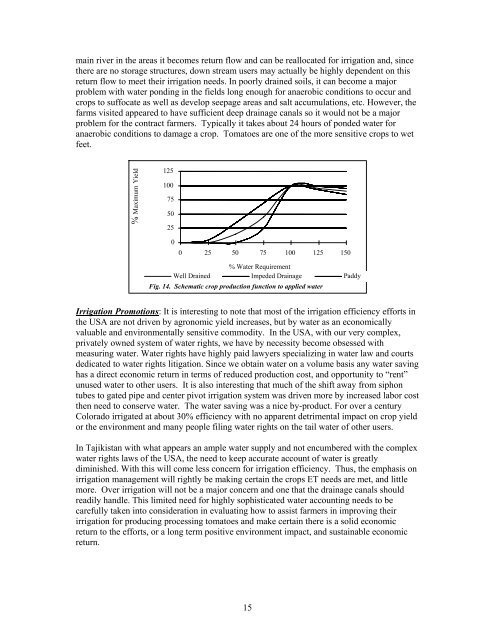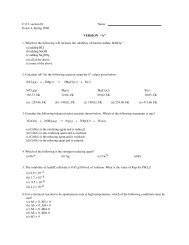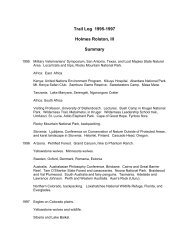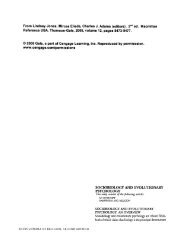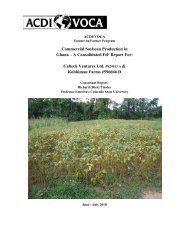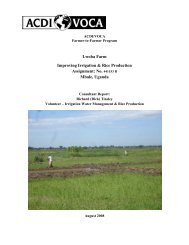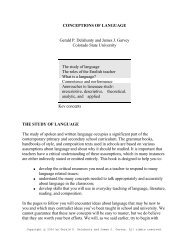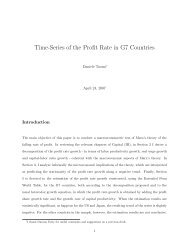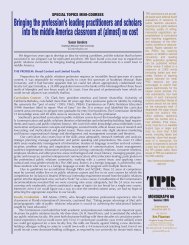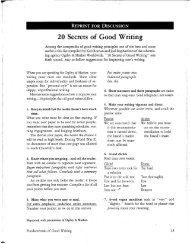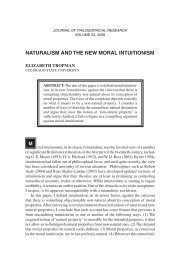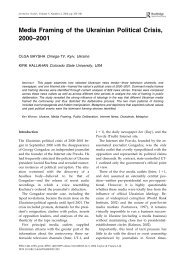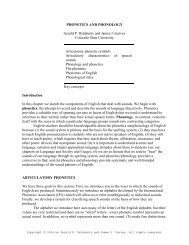Geha Foods Evaluation of Irrigation for Processed Tomatoes
Geha Foods Evaluation of Irrigation for Processed Tomatoes
Geha Foods Evaluation of Irrigation for Processed Tomatoes
You also want an ePaper? Increase the reach of your titles
YUMPU automatically turns print PDFs into web optimized ePapers that Google loves.
main river in the areas it becomes return flow and can be reallocated <strong>for</strong> irrigation and, since<br />
there are no storage structures, down stream users may actually be highly dependent on this<br />
return flow to meet their irrigation needs. In poorly drained soils, it can become a major<br />
problem with water ponding in the fields long enough <strong>for</strong> anaerobic conditions to occur and<br />
crops to suffocate as well as develop seepage areas and salt accumulations, etc. However, the<br />
farms visited appeared to have sufficient deep drainage canals so it would not be a major<br />
problem <strong>for</strong> the contract farmers. Typically it takes about 24 hours <strong>of</strong> ponded water <strong>for</strong><br />
anaerobic conditions to damage a crop. <strong>Tomatoes</strong> are one <strong>of</strong> the more sensitive crops to wet<br />
feet.<br />
% Maximum Yield<br />
125<br />
100<br />
75<br />
50<br />
25<br />
0<br />
0 25 50 75 100 125 150<br />
Well Drained<br />
% Water Requirement<br />
Impeded Drainage Paddy<br />
Fig. 14. Schematic crop production function to applied water<br />
<strong>Irrigation</strong> Promotions: It is interesting to note that most <strong>of</strong> the irrigation efficiency ef<strong>for</strong>ts in<br />
the USA are not driven by agronomic yield increases, but by water as an economically<br />
valuable and environmentally sensitive commodity. In the USA, with our very complex,<br />
privately owned system <strong>of</strong> water rights, we have by necessity become obsessed with<br />
measuring water. Water rights have highly paid lawyers specializing in water law and courts<br />
dedicated to water rights litigation. Since we obtain water on a volume basis any water saving<br />
has a direct economic return in terms <strong>of</strong> reduced production cost, and opportunity to “rent”<br />
unused water to other users. It is also interesting that much <strong>of</strong> the shift away from siphon<br />
tubes to gated pipe and center pivot irrigation system was driven more by increased labor cost<br />
then need to conserve water. The water saving was a nice by-product. For over a century<br />
Colorado irrigated at about 30% efficiency with no apparent detrimental impact on crop yield<br />
or the environment and many people filing water rights on the tail water <strong>of</strong> other users.<br />
In Tajikistan with what appears an ample water supply and not encumbered with the complex<br />
water rights laws <strong>of</strong> the USA, the need to keep accurate account <strong>of</strong> water is greatly<br />
diminished. With this will come less concern <strong>for</strong> irrigation efficiency. Thus, the emphasis on<br />
irrigation management will rightly be making certain the crops ET needs are met, and little<br />
more. Over irrigation will not be a major concern and one that the drainage canals should<br />
readily handle. This limited need <strong>for</strong> highly sophisticated water accounting needs to be<br />
carefully taken into consideration in evaluating how to assist farmers in improving their<br />
irrigation <strong>for</strong> producing processing tomatoes and make certain there is a solid economic<br />
return to the ef<strong>for</strong>ts, or a long term positive environment impact, and sustainable economic<br />
return.<br />
15


